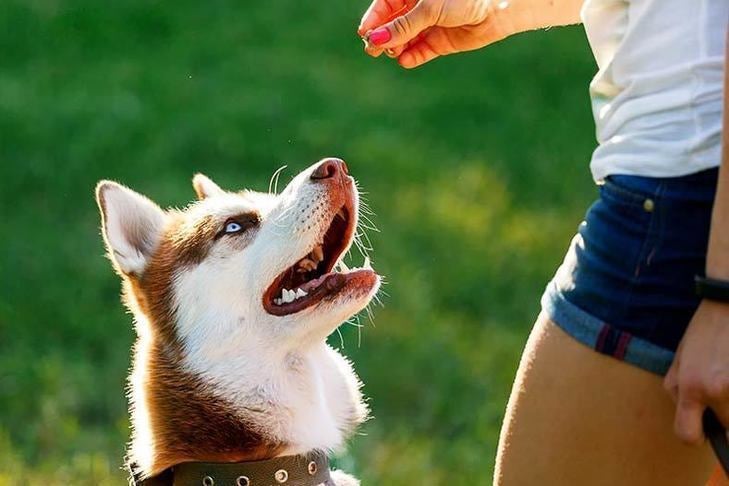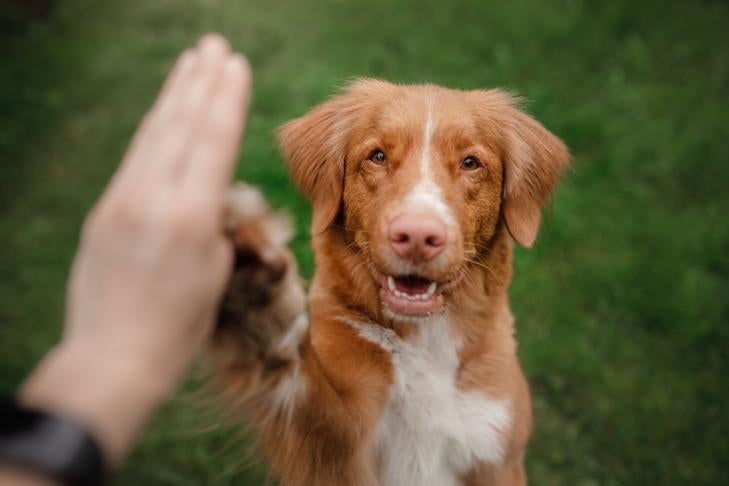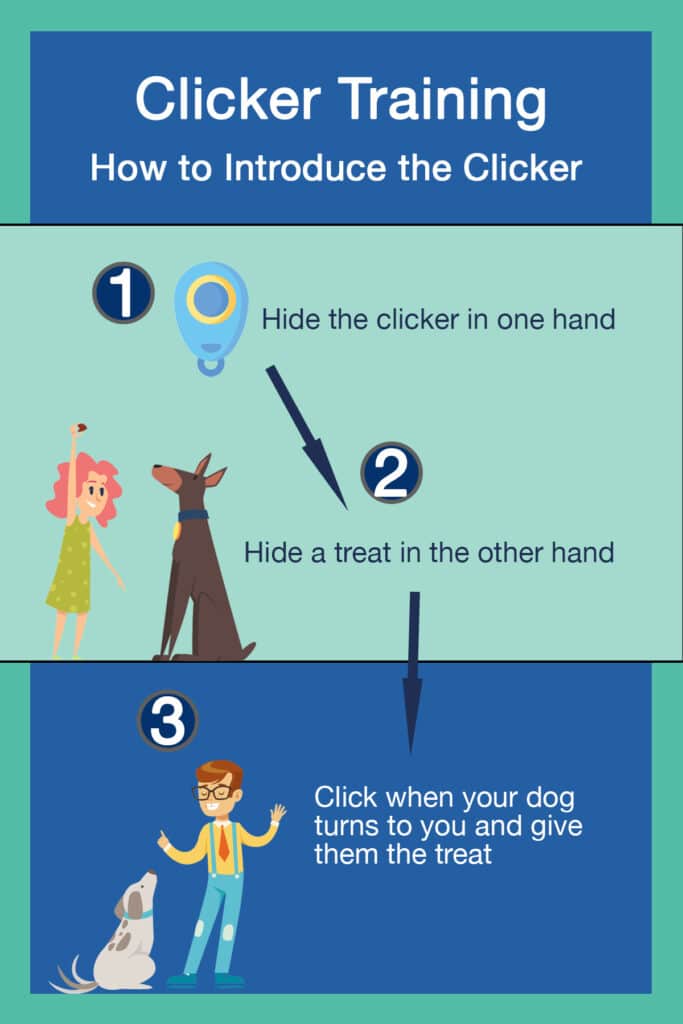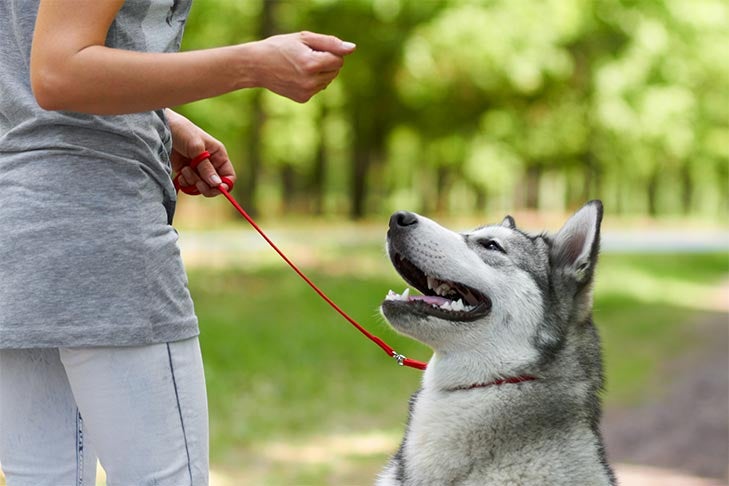Introduction

Introduction:
Positive reinforcement is a powerful tool in dog training that can lead to a strong bond between owners and their furry companions. One effective method that harnesses the power of positive reinforcement is clicker training. This technique utilizes a small device, known as a clicker, to mark desired behaviors in dogs, followed by rewards. Clicker training has gained popularity due to its ability to communicate with dogs in a clear and consistent manner, making it easier for them to understand and learn. In this article, we will explore the science behind clicker training, its benefits, and how to effectively implement this training technique for a well-behaved and happy dog.
Understanding positive reinforcement in dog training

Positive reinforcement is a fundamental principle in dog training, focusing on rewarding desired behaviors instead of punishing unwanted ones. By using positive reinforcement, trainers create a positive learning environment that fosters trust and encourages dogs to willingly participate in training sessions.
Positive reinforcement involves providing rewards such as treats, praise, or playtime when a dog successfully performs a desired behavior. This method helps dogs associate the behavior with positive outcomes, motivating them to repeat it in the future. Unlike punishment-based training, which can cause fear or aggression, positive reinforcement builds a strong bond between the dog and trainer, leading to long-term behavior changes and a happy, well-adjusted canine companion.
Benefits of clicker training for dogs

Using positive reinforcement techniques like clicker training can have many benefits for dogs.
One of the main advantages is that it helps to strengthen the bond between the dog and their owner. Since clicker training relies on rewards and praise, it creates a positive and enjoyable experience for both parties involved. This enhances communication and trust, leading to a stronger relationship.
Additionally, clicker training allows for precise and clear communication. The sound of the clicker serves as a distinct marker for the desired behavior, making it easier for dogs to understand what is expected of them.
Furthermore, clicker training promotes mental stimulation for dogs. It engages their cognitive abilities as they learn new commands and tricks, preventing boredom and providing them with a sense of purpose.
Overall, clicker training is a powerful and effective method that benefits dogs by strengthening the bond with their owners, improving communication, and providing mental stimulation.
What is Clicker Training?

Clicker training is a highly effective method of positive reinforcement training for dogs. It is based on the principles of operant conditioning, which involves associating a specific behavior with a positive reward. In clicker training, a small handheld device called a clicker is used to mark the desired behavior. The clicker emits a distinct sound, which serves as a clear and consistent signal to the dog that they have performed the correct action. This allows for precise timing and helps the dog understand what behavior is being rewarded. Clicker training can be used to teach basic commands, shape behavior, and even address more complex issues such as aggression or fear-based behaviors.
The science behind clicker training

Clicker training for dogs is rooted in the principles of behavioral psychology. It is based on the concept of positive reinforcement, which involves rewarding desired behaviors to increase their frequency. The clicker acts as a conditioned reinforcer, providing a clear and consistent signal to the dog that a reward is coming.
When the dog associates the sound of the clicker with a reward, it strengthens the neural pathways in the brain and enhances learning. This is known as classical conditioning. The clicker captures a moment of desired behavior, making it easier for the dog to understand what is being reinforced. Using the clicker as a marker provides precise timing and ensures that the association between the behavior and the reward is clear to the dog.
Through the science behind clicker training, dogs learn to associate specific behaviors with positive outcomes, leading to faster and more effective learning.
How the clicker works in dog training

The clicker is a small handheld device that emits a distinct clicking sound when pressed. It serves as a means of communication between the trainer and the dog during clicker training. The clicker works by pairing the sound of the click with a reward. When the dog performs a desired behavior, such as sitting or lying down, the trainer immediately clicks the clicker and follows it with a treat or praise. This click-and-reward association helps the dog understand that the behavior they just performed is what the trainer wants. The clicker becomes a signal that signifies "Good job!" to the dog, making it a powerful tool in dog training.
Getting Started with Clicker Training

Choosing the right clicker for your dog is an important first step in clicker training. There are various types of clickers available, ranging from traditional handheld clickers to clickers with adjustable volume control. It's essential to choose a clicker that is comfortable for you to hold and easy for your dog to hear.
Once you have your clicker, you can start setting up a training session with your dog. Find a quiet and distraction-free area where you can focus on training. Have some small treats ready as rewards for your dog's positive behaviors. Begin by introducing the clicker sound to your dog. Click the clicker and immediately give your dog a treat. Repeat this process several times until your dog associates the sound of the clicker with receiving a treat.
With the clicker introduced, you can now move on to teaching basic commands using the clicker. Start with simple commands like "sit" or "lie down." When your dog performs the desired behavior, click the clicker and reward them with a treat. The clicker serves as a clear and distinct marker of the exact moment your dog did something right, making it easier for them to understand what behavior is being reinforced.
In addition to teaching basic commands, clicker training allows you to shape behavior through positive reinforcement. This technique involves breaking down complex behaviors into smaller achievable steps. For example, if you want to teach your dog to roll over, you would reward them for small movements towards rolling over, such as lying on their side or turning their head. By gradually reinforcing these smaller behaviors, you can eventually shape the complete behavior of rolling over.
As you progress with clicker training, you can also explore advanced techniques such as teaching complex tricks and problem-solving. The clicker can be used to teach your dog a wide range of impressive tricks, from playing dead to fetching specific items. Additionally, if your dog exhibits problem behaviors like aggression or fear-based reactions, clicker training can be an effective tool for behavior modification. By rewarding alternative desirable behaviors, you can help your dog overcome these issues in a positive and gentle manner.
To ensure successful clicker training sessions, timing and consistency are crucial. Click the clicker at the exact moment your dog performs the desired behavior, followed immediately by a treat. Consistency in using the clicker and rewarding your dog will help them understand what behaviors are being reinforced. Additionally, maintaining motivation and engagement during training sessions is important. Keep the training sessions short, fun, and rewarding to keep your dog excited and eager to participate.
While clicker training can be highly effective, it's important to avoid common mistakes. Overusing the clicker can make your dog dependent on the sound instead of focusing on the desired behavior. Remember that the clicker is just a tool to mark and reinforce positive behaviors. Furthermore, using ineffective reinforcement strategies, such as using inappropriate or inconsistent rewards, can hinder your dog's progress in learning.
In conclusion, clicker training is a powerful and positive method for training dogs. By understanding the basics of clicker training and following the right techniques, you can build a strong bond with your dog while teaching them new skills and improving their behavior. If you're interested in learning more about clicker training, there are plenty of resources available online and professional trainers who can provide further guidance and support.
Choosing the right clicker for your dog
When it comes to clicker training for dogs, choosing the right clicker is essential for effective communication with your pet. There are various types of clickers available, so it's important to select one that suits your dog's needs and preferences.
Consider the size of the clicker and ensure it is comfortable for your hand and easy to handle. Some clickers come with adjustable volume settings, allowing you to choose a tone that is audible to your dog without being too loud or startling. Additionally, opt for a clicker that is durable and can withstand the wear and tear of training sessions. By selecting the right clicker, you can enhance the training experience and create a positive association for your dog.
Setting up a training session with your dog

Setting up a training session with your dog is an important step in clicker training. Before you begin, ensure that you have a comfortable and distraction-free environment. Find a quiet space where you and your dog can focus without any interruptions. Gather all the necessary training equipment, including treats, a clicker, and any props needed for specific exercises. It's also crucial to choose a time when both you and your dog are in the right mindset for training. Make sure your dog is well-rested, has had some exercise, and is ready to engage with you. By setting up a conducive training environment, you increase the likelihood of a successful session.
Basic Clicker Training Techniques

Basic Clicker Training Techniques involve teaching basic commands using the clicker and shaping behavior through positive reinforcement. The clicker is used to mark the desired behavior instantly, followed by a reward. For example, when teaching the "sit" command, the trainer would click the clicker when the dog's rear end touches the ground and then give a treat. Over time, the dog associates the clicking sound with the reward and learns to perform the desired action. Shaping behavior involves breaking down complex behaviors into smaller steps and rewarding each step until the final desired behavior is achieved. This technique helps dogs understand and respond to commands more effectively.
Teaching basic commands using the clicker

When it comes to teaching basic commands to your dog, clicker training can be an incredibly effective method. By associating the sound of the clicker with rewards, you can communicate to your dog exactly what behavior you want them to perform. To teach a basic command such as "sit" using the clicker, you would first wait for your dog to naturally sit or help guide them into the position. As soon as their bottom touches the ground, you click the clicker and immediately provide a treat or verbal praise. Consistency and repetition are key in reinforcing the association between the clicker, the desired behavior, and the reward.
Shaping behavior through positive reinforcement

Shaping behavior through positive reinforcement is a fundamental aspect of clicker training for dogs. This technique involves breaking down desired behaviors into smaller, manageable steps, and reinforcing each step along the way.
For example, let's say you want to teach your dog to roll over. You would start by rewarding any slight movement towards a roll, such as a head tilt or a shoulder rotation. As your dog progresses and starts to perform a more complete roll, you can increase the criteria for reinforcement.
By shaping behavior in this way, you are encouraging your dog to actively participate in the learning process and making the desired behavior more likely to occur. This approach allows for gradual progress and helps build a strong foundation for more complex commands and tricks.
Advanced Clicker Training Techniques

Teaching complex tricks with the clicker can take your dog's training to the next level. Advanced clicker training techniques involve breaking down complex behaviors into smaller steps and rewarding each step along the way. For example, if you want to teach your dog to fetch a specific toy, you can start by rewarding them for simply touching the toy, then for picking it up, and finally for bringing it back to you. This method of shaping behavior through positive reinforcement allows your dog to understand and execute more intricate tasks. Additionally, clicker training can be effective for problem-solving and behavior modification, helping address issues such as separation anxiety or fear-based behaviors. By breaking down the desired behavior into small steps and rewarding each successful attempt, clicker training can help your dog overcome these challenges and develop more positive behaviors.
Teaching complex tricks with the clicker

Teaching complex tricks with the clicker requires patience, consistency, and a clear understanding of how to break down the behavior into smaller, manageable steps. With clicker training, you can effectively teach your dog impressive tricks such as spinning, weaving through your legs, or even playing dead.
Start by capturing the behavior you want with the clicker and reinforcing it consistently. For example, if you want your dog to spin, click and treat them when they start turning in the desired direction. Gradually increase your criteria by only clicking and rewarding when they spin more completely. With practice and repetition, your dog will learn to perform these complex tricks with ease.
Problem-solving and behavior modification using clicker training

Problem-solving and behavior modification using clicker training can be highly effective for addressing various issues in dogs. Whether it's excessive barking, jumping on guests, or pulling on the leash, clicker training can help modify these unwanted behaviors. The key is to break down the problem behavior into smaller, manageable steps and use the clicker to mark and reward desired behaviors. For example, if the dog tends to jump on guests, the clicker can be used to reinforce sitting or staying calm when someone enters the house. Over time, the dog will learn that these behaviors are more rewarding than jumping, leading to behavior modification and improved manners. Through consistent clicker training, dogs can overcome behavioral challenges and develop positive habits.
Clicker Training for Specific Dog Training Needs
Clicker training can be a valuable tool for addressing specific training needs in dogs. One area where clicker training can be particularly effective is in housebreaking and crate training. By using the clicker to reinforce desired behaviors such as going to the bathroom outside or settling quietly in their crate, dogs can quickly learn the correct behaviors.
Clicker training can also be used to address aggression and fear-based behaviors. By using positive reinforcement and rewarding calm and non-aggressive behaviors, dogs can learn to replace their negative reactions with more appropriate ones.
In both of these specific training needs, clicker training helps to create a positive association with the desired behaviors and encourages dogs to make the right choices.
Housebreaking and crate training with the clicker
Housebreaking and crate training are essential aspects of raising a well-behaved and house-trained dog. Clicker training can be a powerful tool in teaching your dog proper bathroom habits and crate manners.
When it comes to housebreaking, the clicker can be used to reinforce desired behavior when your dog eliminates in the designated area. Each time your dog successfully eliminates in the right spot, click and reward them with a treat. This positive reinforcement helps them associate the behavior with a reward, making them more likely to repeat it in the future.
Crate training can also benefit from clicker training. You can use the clicker to reward your dog when they enter the crate willingly or remain calm inside it. By associating the click with positive experiences in the crate, your dog will learn to view the crate as a safe and comfortable space.
Remember to gradually increase the duration your dog spends in the crate, always rewarding them with a click and treat for good behavior. With consistent clicker training, your dog will learn to see the crate as their own den and willingly go inside without any resistance.
Clicker training for aggression and fear-based behaviors

When it comes to addressing aggression and fear-based behaviors in dogs, clicker training can be a powerful tool. By using positive reinforcement techniques, the clicker can help dogs overcome their anxieties and learn more appropriate behaviors.
To begin, clicker training can be used to counter-condition aggressive responses. By associating the clicker with positive experiences, such as treats or praise, the dog begins to form positive associations with the trigger of their aggression. This process helps to reduce their fear and reactivity and replaces it with more relaxed and controlled behavior.
Furthermore, clicker training is effective in addressing fear-based behaviors. By breaking down the fearful situation into small manageable steps, the clicker can be used to reward calm and confident behavior, gradually desensitizing the dog to their fear. This method allows the dog to build trust and confidence, leading to a reduction in their fearful responses over time.
Overall, clicker training provides a positive and effective approach to addressing aggression and fear-based behaviors in dogs. With patience, consistency, and the guidance of a professional trainer if needed, it is possible to help dogs overcome their fears and become happier, more well-adjusted companions.
Tips and Tricks for Successful Clicker Training

Timing and consistency are crucial elements in successful clicker training. It's important to click at the exact moment your dog performs the desired behavior, as this creates a clear association between the behavior and the reward. Consistency in timing helps your dog understand what is being reinforced. Additionally, ensure that you use the clicker consistently throughout training sessions. Varying the timing or frequency of clicks can confuse your dog and hinder their progress. Another tip is to keep training sessions short and focused to maintain your dog's motivation and engagement. Remember to always end on a positive note to keep your dog eager for the next training session.
Timing and consistency in clicker training

Timing and consistency play a crucial role in clicker training for dogs. The timing of the click is essential in giving the dog immediate feedback about their desired behavior. It should be done at the exact moment the behavior occurs to ensure proper association. Consistency is equally important as it helps the dog understand what is expected of them. Clicking and treating inconsistently can lead to confusion and slow down the learning process. By maintaining a consistent clicker training schedule and using clear signals, such as clicks and treats, dog owners can effectively communicate with their furry companions and reinforce positive behaviors.
Maintaining motivation and engagement during training sessions

Maintaining motivation and engagement during training sessions is crucial for the success of clicker training. To keep your dog motivated and eager to learn, it is important to make the training sessions enjoyable and rewarding for them.
One way to maintain motivation is by utilizing high-value treats or rewards that your dog finds particularly enticing. This could be small pieces of cooked chicken, cheese, or other tasty treats that your dog loves. By using these special rewards exclusively during training, you can create a strong association between training and positive reinforcement.
Additionally, it is important to keep the training sessions short and fun. Dogs have short attention spans, so keeping the sessions brief and engaging will help prevent them from getting bored or losing focus. Break the training into smaller tasks or commands and reward your dog frequently for their successes.
Adding variety to the training sessions can also help maintain motivation. Incorporate different exercises, tricks, or games to keep your dog mentally stimulated and interested in the training process. This could include introducing new challenges or gradually increasing the difficulty of commands.
Lastly, it is important to provide plenty of praise, petting, and positive reinforcement during the training sessions. Dogs thrive on positive feedback and will be motivated to continue learning when they feel supported and encouraged.
By maintaining motivation and engagement during training sessions, you can foster a positive and enjoyable learning experience for your dog, leading to quicker progress and a stronger bond between you and your pet.
Common Mistakes to Avoid in Clicker Training

When utilizing clicker training for dogs, there are some common mistakes that trainers should avoid in order to maximize effectiveness. One mistake is overusing the clicker, which can lead to the dog becoming dependent on the sound rather than responding to the actual command. It is important to gradually fade out the clicker and replace it with verbal cues to ensure long-term success. Additionally, using ineffective reinforcement strategies, such as providing inconsistent rewards or failing to find the right motivation for the dog, can hinder progress. By understanding these mistakes and taking proactive steps to avoid them, trainers can ensure a successful clicker training experience.
Overusing the clicker and becoming dependent on it

Overusing the clicker and becoming dependent on it can be a common mistake in clicker training. While the clicker is a powerful tool for positive reinforcement, it is important not to rely on it too heavily.
Using the clicker for every single behavior can create a dependency where the dog only responds when they hear the clicker. This can limit their ability to perform without the clicker present.
To avoid this, gradually decrease the use of the clicker over time. Start by incorporating verbal cues alongside the clicker and eventually phase out the clicker altogether. This will help the dog understand that their behavior should be reinforced regardless of the presence of the clicker.
Using ineffective reinforcement strategies

Many dog owners may unknowingly use ineffective reinforcement strategies during clicker training, which can hinder progress and confuse their pets. One common mistake is providing inconsistent rewards, such as occasionally giving treats for desired behavior and other times not. This inconsistency can cause confusion and frustration in the dog, leading to inconsistent performance. Another ineffective strategy is using punishment or negative reinforcement alongside positive reinforcement. This can create fear and anxiety in the dog, ultimately undermining the trust and bond between the owner and pet. It is essential to understand and use positive reinforcement techniques consistently to ensure successful clicker training.
Conclusion

The power of positive reinforcement through clicker training offers numerous benefits for dog owners and their furry companions. By understanding the principles of positive reinforcement and utilizing the clicker as a training tool, dog owners can effectively teach their dogs new commands, shape desired behaviors, and even address problem behaviors. Through consistency, timing, and motivation, clicker training can lead to long-term behavior changes in dogs. Additionally, resources for further learning and support in clicker training are readily available, ensuring that dog owners can continue to enhance their training skills and strengthen their bond with their four-legged friends. With the power of positive reinforcement, clicker training proves to be a valuable tool in shaping a well-behaved and happy dog.
The long-term benefits of positive reinforcement training

Positive reinforcement training has numerous long-term benefits for dogs. Firstly, it strengthens the bond between the dog and the trainer, fostering a positive and trusting relationship. This training method also enhances the dog's confidence and self-esteem, as they learn to associate their actions with rewards. Additionally, positive reinforcement training promotes good behavior and prevents the development of negative behaviors. Since dogs are motivated by rewards, they are more likely to repeat desired behaviors, leading to improved obedience and responsiveness. Moreover, positive reinforcement training is a humane and effective approach that creates a harmonious and happy environment for both dogs and their human companions. By focusing on positive reinforcement, trainers can achieve long-lasting behavioral changes that enhance the overall well-being of their furry friends.
Resources for further learning and support in clicker training

There are various resources available for dog owners who want to dive deeper into clicker training and seek additional learning and support. One option is to enroll in obedience classes or workshops that specifically focus on positive reinforcement training methods, including clicker training. Many professional dog trainers offer these classes and can provide hands-on guidance and feedback. Additionally, there are numerous online resources, such as websites, forums, and instructional videos, that offer step-by-step guides and instructional materials for clicker training. These resources can be valuable tools for dog owners looking for further learning and support as they explore the power of positive reinforcement in training their furry companions.




0 Comments